Abstract
1. Commonly used loop diuretics produce side effects in man which are similar to chemically induced myotonia. These diuretics have structural affinity with known myotonic agents. 2. We have observed EMG myotonia in vivo in leg muscles of rats treated with intravenous frusemide. 3. In the presence of several different diuretics, rat isolated diaphragm, soleus and extensor digitorum longus muscles as well as frog sartorius muscles produce typically myotonic contractions with relaxation times up to several seconds. 4. Intracellular recording of action potentials from diuretic-treated muscles reveals long lasting after-discharges following a brief electrical stimulus, again typical of chemically induced myotonia. 5. Having demonstrated a myotonic action of several diuretics we suggest a need for caution in using these drugs in persons with hereditary myotonia and a need to be aware of possible provocation of myotonia in subclinical cases. Myopathies and neuropathies which are known to result from chronic exposure to myotonic agents also need to be considered. 6. In our study, the diuretic, acetazolamide, unmasked subthreshold myotonia. This seems to be at variance with reports of its usefulness in the treatment of myotonia. 7. Diuretics should probably not be employed in the treatment of herbicide intoxication where their myotonic activity would be expected to add to the known myotonic activity of the herbicide.
Full text
PDF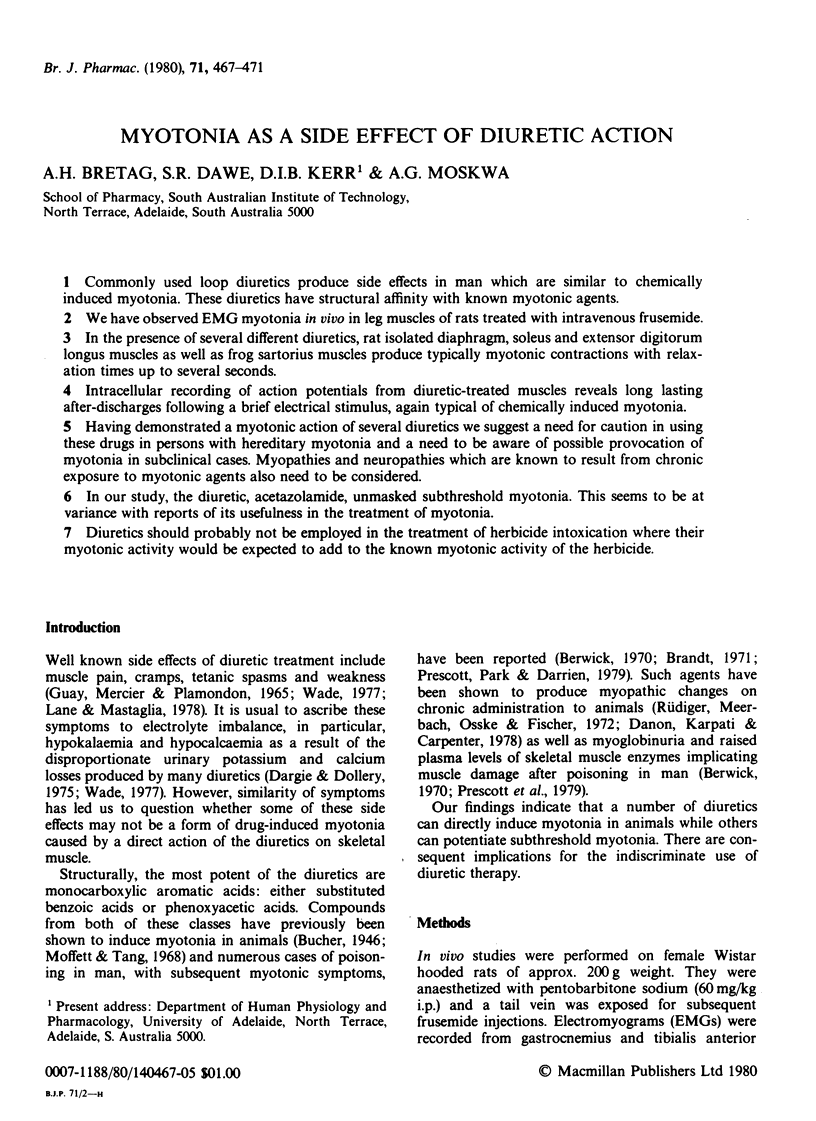
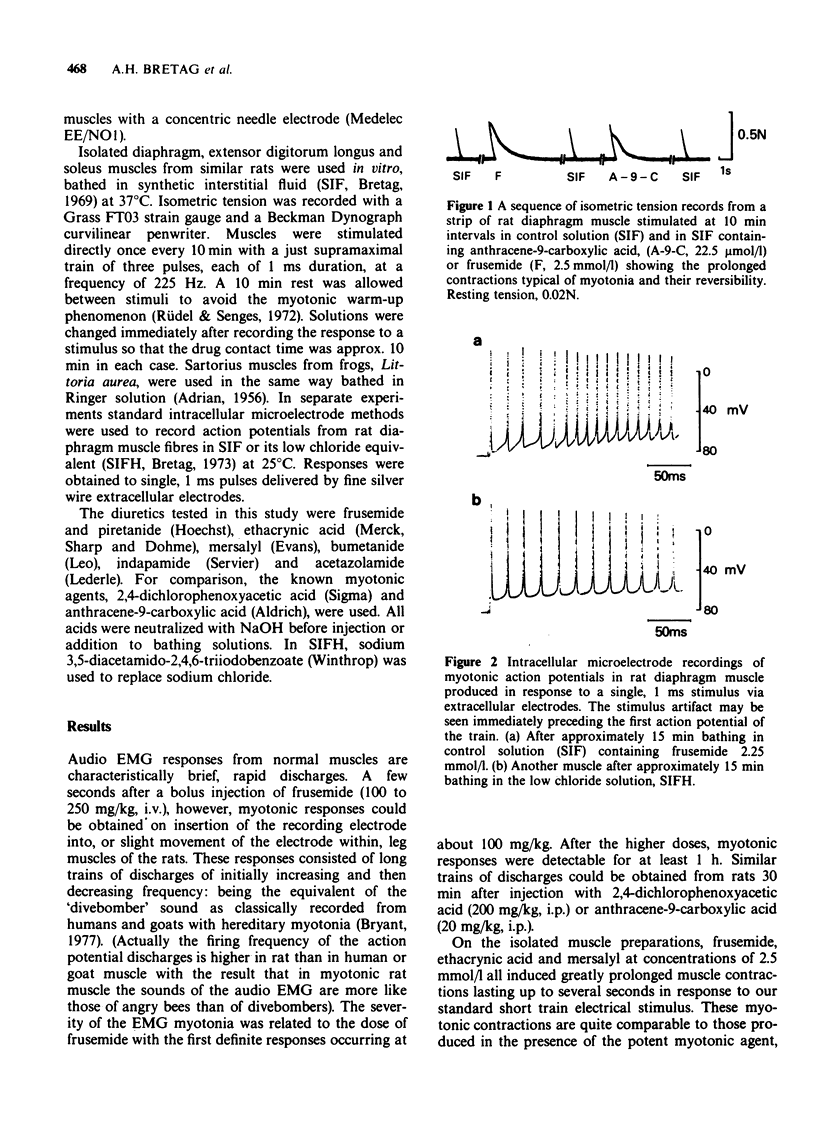
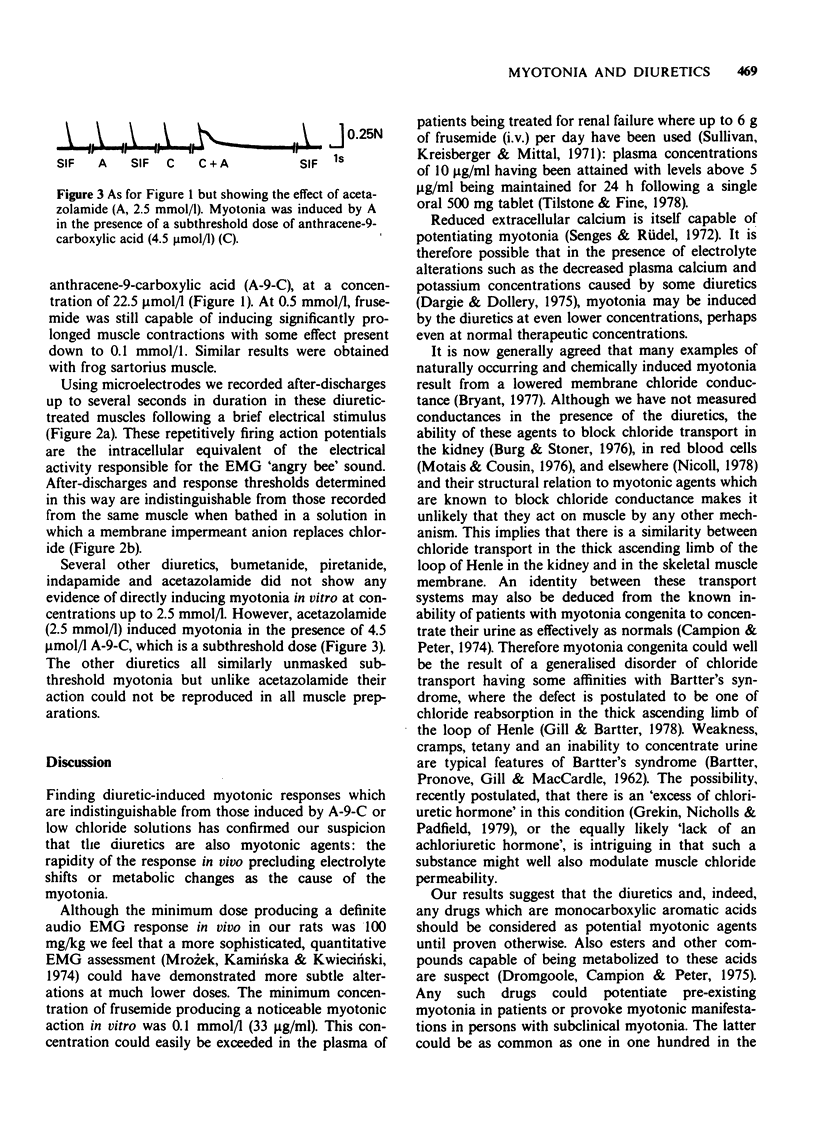
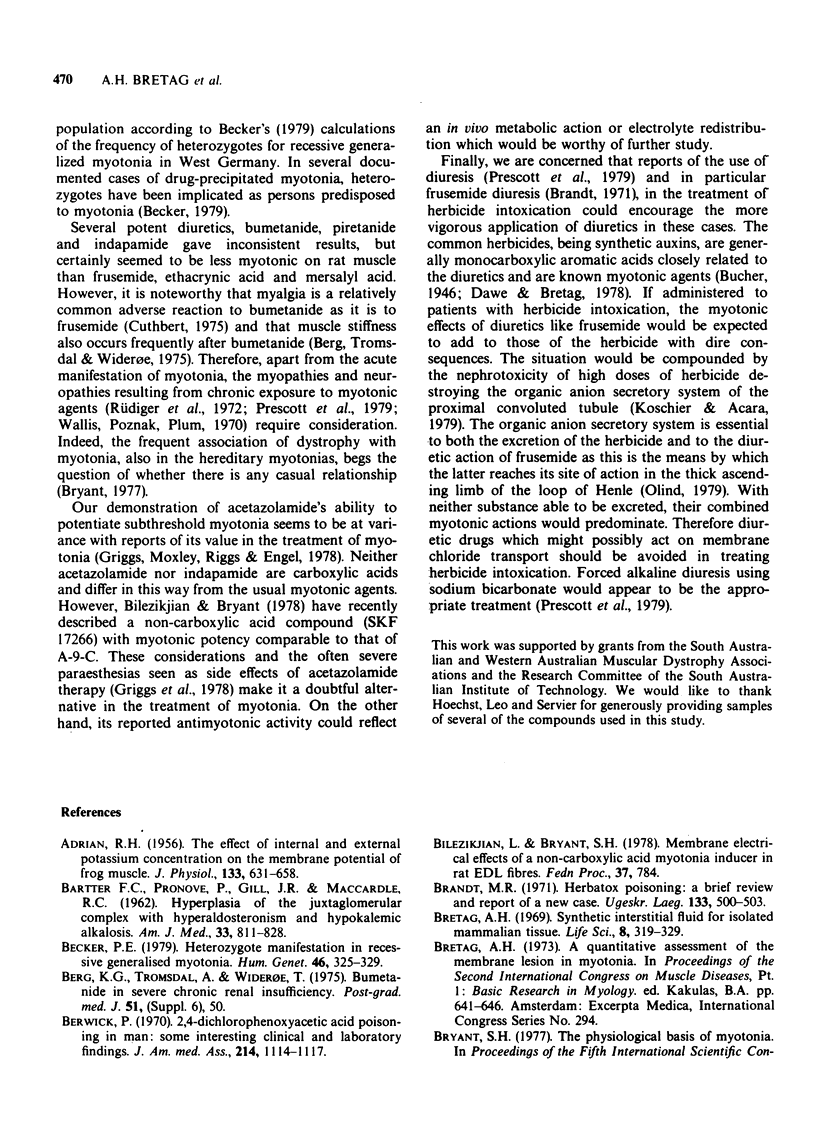
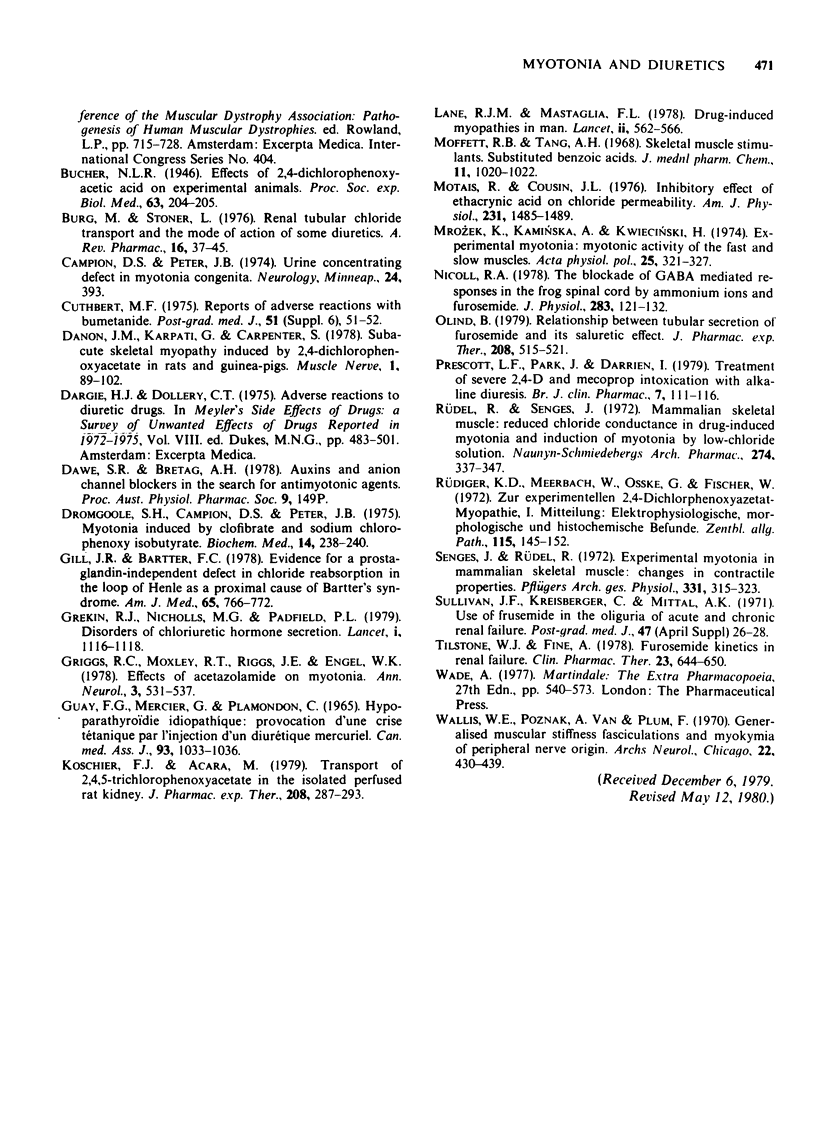
Selected References
These references are in PubMed. This may not be the complete list of references from this article.
- ADRIAN R. H. The effect of internal and external potassium concentration on the membrane potential of frog muscle. J Physiol. 1956 Sep 27;133(3):631–658. doi: 10.1113/jphysiol.1956.sp005615. [DOI] [PMC free article] [PubMed] [Google Scholar]
- BARTTER F. C., PRONOVE P., GILL J. R., Jr, MACCARDLE R. C. Hyperplasia of the juxtaglomerular complex with hyperaldosteronism and hypokalemic alkalosis. A new syndrome. Am J Med. 1962 Dec;33:811–828. doi: 10.1016/0002-9343(62)90214-0. [DOI] [PubMed] [Google Scholar]
- Becker P. E. Heterozygote manifestation in recessive generalized myotonia. Hum Genet. 1979 Feb 15;46(3):325–329. doi: 10.1007/BF00273316. [DOI] [PubMed] [Google Scholar]
- Berwick P. 2,4-dichlorophenoxyacetic acid poisoning in man. Some interesting clinical and laboratory findings. JAMA. 1970 Nov 9;214(6):1114–1117. [PubMed] [Google Scholar]
- Brandt M. R. Herbatoxforgiftning. En kort oversigt og et nyt tilfaelde. Ugeskr Laeger. 1971 Mar 19;133(11):500–503. [PubMed] [Google Scholar]
- Bretag A. H. Synthetic interstitial fluid for isolated mammalian tissue. Life Sci. 1969 Mar 1;8(5):319–329. doi: 10.1016/0024-3205(69)90283-5. [DOI] [PubMed] [Google Scholar]
- Burg M., Stoner L. Renal tubular chloride transport and the mode of action of some diuretics. Annu Rev Physiol. 1976;38:37–45. doi: 10.1146/annurev.ph.38.030176.000345. [DOI] [PubMed] [Google Scholar]
- Cuthbert M. F. Reports of adverse reactions with bumetanide. Postgrad Med J. 1975;51 (Suppl 6):51–52. [PubMed] [Google Scholar]
- Danon J. M., Karpati G., Carpenter S. Subacute skeletal myopathy induced by 2,4-dichlorophenoxyacetate in rats and guinea pigs. Muscle Nerve. 1978 Mar-Apr;1(2):89–102. doi: 10.1002/mus.880010202. [DOI] [PubMed] [Google Scholar]
- Dromgoole S. H., Campion D. S., Peter J. B. Myotonia induced by clofibrate and sodium chlorophenoxy isobutyrate. Biochem Med. 1975 Oct;14(2):238–240. doi: 10.1016/0006-2944(75)90041-1. [DOI] [PubMed] [Google Scholar]
- Gill J. R., Jr, Bartter F. C. Evidence for a prostaglandin-independent defect in chloride reabsorption in the loop of Henle as a proximal cause of Bartter's syncrome. Am J Med. 1978 Nov;65(5):766–772. doi: 10.1016/0002-9343(78)90794-5. [DOI] [PubMed] [Google Scholar]
- Grekin R. J., Nicholls M. G., Padfield P. L. Disorders of chloriuretic hormone secretion. Lancet. 1979 May 26;1(8126):1116–1118. doi: 10.1016/s0140-6736(79)91794-x. [DOI] [PubMed] [Google Scholar]
- Griggs R. C., Moxley R. T., 3rd, Riggs J. E., Engel W. K. Effects of acetazolamide on myotonia. Ann Neurol. 1978 Jun;3(6):531–537. doi: 10.1002/ana.410030614. [DOI] [PubMed] [Google Scholar]
- Guay F. G., Mercier G., Plamondon C. Hypoparathyroïdie idiopathique: provocation d'une crise tétanique par l'injection d'un diurétique mercuriel. Can Med Assoc J. 1965 Nov 6;93(19):1033–1036. [PMC free article] [PubMed] [Google Scholar]
- Koschier F. J., Acara M. Transport of 2,4,5-trichlorophenoxyacetate in the isolated, perfused rat kidney. J Pharmacol Exp Ther. 1979 Feb;208(2):287–293. [PubMed] [Google Scholar]
- Lane R. J., Mastaglia F. L. Drug-induced myopathies in man. Lancet. 1978 Sep 9;2(8089):562–566. doi: 10.1016/s0140-6736(78)92894-5. [DOI] [PubMed] [Google Scholar]
- Moffett R. B., Tang A. H. Skeletal muscle stimulants. Substituted benzoic acids. J Med Chem. 1968 Sep;11(5):1020–1022. doi: 10.1021/jm00311a023. [DOI] [PubMed] [Google Scholar]
- Motais R., Cousin J. L. Inhibitory effect of ethacrynic acid on chloride permeability. Am J Physiol. 1976 Nov;231(5 Pt 1):1485–1489. doi: 10.1152/ajplegacy.1976.231.5.1485. [DOI] [PubMed] [Google Scholar]
- Mrozek K., Kamińska A., Kwieciński H. Experimental myotonia. Myotonic activity of the fast and slow muscles. Acta Physiol Pol. 1974 Jul-Aug;25(4):321–327. [PubMed] [Google Scholar]
- Nicoll R. A. The blockade of GABA mediated responses in the frog spinal cord by ammonium ions and furosemide. J Physiol. 1978 Oct;283:121–132. doi: 10.1113/jphysiol.1978.sp012491. [DOI] [PMC free article] [PubMed] [Google Scholar]
- Prescott L. F., Park J., Darrien I. Treatment of severe 2,4-D and mecoprop intoxication with alkaline diuresis. Br J Clin Pharmacol. 1979 Jan;7(1):111–116. doi: 10.1111/j.1365-2125.1979.tb00906.x. [DOI] [PMC free article] [PubMed] [Google Scholar]
- Rüdel R., Senges J. Mammalian skeletal muscle: reduced chloride conductance in drug-induced myotonia and induction of myotonia by low-chloride solution. Naunyn Schmiedebergs Arch Pharmacol. 1972;274(4):337–347. doi: 10.1007/BF00501271. [DOI] [PubMed] [Google Scholar]
- Rüdiger K. D., Meerbach W., Osske G., Fischer W. Zur experimentellen 2,4-Dichlorphenoxyazetat-Myopathie. I. Elektrophysiologische, morphologische und histochemische Befunde. Zentralbl Allg Pathol. 1972;115(1):145–152. [PubMed] [Google Scholar]
- Senges J., Rüdel R. Experimental myotonia in mammalian skeletal muscle: changes in contractile properties. Pflugers Arch. 1972;331(4):315–323. doi: 10.1007/BF00592692. [DOI] [PubMed] [Google Scholar]
- Sullivan J. F., Kreisberger C., Mittal A. K. Use of frusemide in the oliguria of acute and chronic renal failure. Postgrad Med J. 1971 Apr;47(Suppl):26–28. [PubMed] [Google Scholar]
- Tilstone W. J., Fine A. Furosemide kinetics in renal failure. Clin Pharmacol Ther. 1978 Jun;23(6):644–650. doi: 10.1002/cpt1978236644. [DOI] [PubMed] [Google Scholar]
- Wallis W. E., Van Poznak A., Plum F. Generalized muscular stiffness, fasciculations, and myokymia of peripheral nerve origin. Arch Neurol. 1970 May;22(5):430–439. doi: 10.1001/archneur.1970.00480230048005. [DOI] [PubMed] [Google Scholar]


